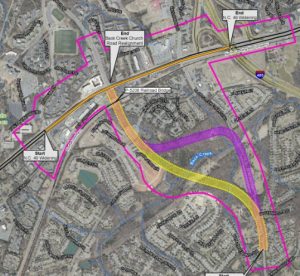ARTICLE UPDATED MARCH 19, 2019
The state Department of Transportation will hold a public meeting on April 23 to share plans to transform 1.2 miles of University City Boulevard into a six-lane “Superstreet” and close the Back Creek Church Road railroad crossing.
The meeting will take place 4-7 pm April 23 in the Lucas Room at UNC Charlotte’s Cone University Center.
The meeting will be held drop-in style, with state staff available to explain the project, answer questions and receive comments.
Parking is available at the Cone Parking Deck. Directions
Visit the project website for details and a survey about the plans.
Project details
The state plans to convert part of University City Boulevard near UNC Charlotte, now a four-lane divided highway, into a six-lane “Superstreet”.
The Superstreet design would eliminate most left turns and straight-across traffic between John Kirk Road and I-485. The design is intended to reduce current heavy congestion and help the highway absorb significantly more traffic in the future.
Construction of the $41.8 million project could start as soon as summer 2022.
Along with widening University City Boulevard, the state project has three other significant components:
- Extend Mallard Creek Church Road, which now ends at University City Boulevard, southward under the NC Railroad Corridor. This roadway is also called the Eastern Circumferential.
- Close Back Creek Church Road just south of the NC Railroad Corridor, as a way to improve safety along the rail line.
- Create new ways for local traffic to circulate once the railroad crossing is closed.
The state cites several reasons for the project and its design, including:
Improved traffic volume, speed and safety

Signalized U-turn area on Holly Springs, NC Superstreet. Watch NCDOT video
Traffic studies show that this stretch of University City Boulevard suffers from massive congestion and frequent accidents.
NCDOT says that widening the highway and limiting where cross-traffic and left turns onto the roadway can occur will allow University City Boulevard to handle more traffic at higher speeds while reducing the number of accidents.
The so-called Superstreet design is intended to maximize flow in both directions at all times on the major highway.
Traffic entering the Superstreet from most other streets and businesses must turn right. Drivers wanting to go the other direction may make a U-turn at a limited number of U-turn locations.
Here is a Superstreet video link from NCDOT that explains the design and shows it in action in Holly Springs.
Start of Eastern Circumferential highway
Transportation plans since the 1980s have identified the need for a major north-south highway in eastern Mecklenburg County that would parallel a future outer-belt road. This project will build a short but key piece of that highway, called the Eastern Circumferential.
The state will extend Mallard Creek Church Road about a half mile southward from where it now ends, at University City Boulevard, to an undeveloped stretch of Hanberry Boulevard between the University Heights and Villages of Back Creek neighborhoods.
A bridge to take the new road under the railroad line already exists. It was built for this new roadway when the nearby rail line was improved a few years ago.
A related and concurrent Charlotte-funded project will continue the Eastern Circumferential/Mallard Creek Church Road Extension southward from Hanberry Boulevard to Back Creek Church Road, north of John Stewart Road.
The state plans to build more segments of the Eastern Circumferential over the next 10-15 years.
The goal is to reduce delay in both directions of a main street at all times of the day, according to an NCDOT webpage. This is achieved by limiting the ability of vehicles on side streets from crossing the main street or turning left, except at a few major intersections.
High-speed rail corridor with few train-vehicle collisions
The state has closed dozens of at-grade railroad crossings statewide along the NC Railroad Corridor in the past decade as part of the Piedmont Improvement Program, a $500 million federally funded upgrade of the rail corridor’s capacity, safety and train speeds. Future improvements will increase train speeds on the corridor to about 100 mph.
Many of the crossing closings have been accompanied by construction of alternate routes under or over the tracks.
The closing of the Back Creek Church Road railroad crossing will affect thousands of nearby residents as well as the many people who use this road daily to reach University City, UNC Charlotte and I-485.
The Eastern Circumferential will provide one alternative for traffic now using Back Creek Church Road.
State and Charlotte transportation planners have spent more than a year working through other options, such as possible new surface streets.
Strategic Highway Corridor
Finally, N.C. 49 beginning at the I-85 entrance on North Tryon Street belongs to a special category of NC highways called Strategic Transportation Corridors. These high-volume and high-speed road/rail corridors are considered crucial to the state’s long-range plans to maximize economic development across North Carolina.
The U.S. 64/N.C. 49 Strategic Corridor connects largely rural central North Carolina to Raleigh and Charlotte while serving as an alternative to the I-85/I-40 corridor linking the state’s two biggest cities.
Over the past two decades, the state has systematically improved long stretches of U.S. 64 and N.C. 49 to four-lane or limited-access highway.
Beginning last fall, the state began creating master plans for each corridor, as well. Work has not started on the U.S. 64/N.C. 49 corridor’s master plan.
Learn more
The official designation of the NC 49 and Back Creek Church Road project is STIP Project U-5768.
NCDOT has launched a website – https://publicinput.com/nc-49-widening-charlotte – that provides details of the project, allow visitors to take an online survey about transportation needs and sign up to receive project updates via email or traditional mail.
For additional details contact Diane Wilson, senior public involvement officer for the NCDOT, at pdwilson1@ncdot.gov or (919) 707-6073.





0 Comments